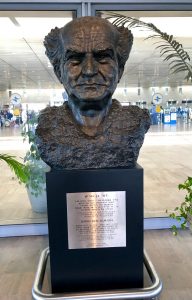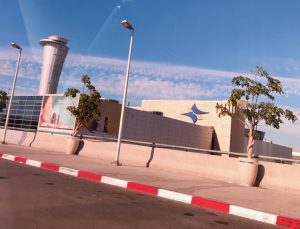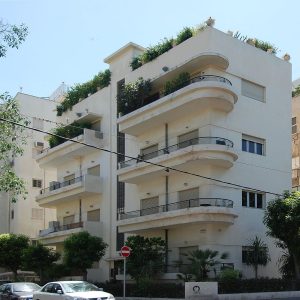Arriving in Israel
 After a nearly 14-hour flight on United Airlines’ relatively new direct flight, inaugurated April 2016, from SFO to Ben Gurion International Airport (TLV), I arrived in Israel at the same time I had left San Francisco the day before.
After a nearly 14-hour flight on United Airlines’ relatively new direct flight, inaugurated April 2016, from SFO to Ben Gurion International Airport (TLV), I arrived in Israel at the same time I had left San Francisco the day before.
The Ben Gurion International Airport has been rated the 8th best airport in the world according to Travel + Leisure magazine. TLV is considered to be one of the safest airports in the world, with layers of security that are only partially visible to its 16 million passengers who pass through ever year. I was given some helpful tips when travelling through TLV, if you’re using a U.S. UK, Canadian, Australian, New Zealand, or Irish passport, visas are issued upon arrival free of charge.



Tel Aviv

Tel Aviv is a major city in Israel located on the country’s Mediterranean coastline. Tel Aviv is the home to many foreign embassies making it the proxy-capitol of Israel, as Israel’s capitol in Jerusalem is not internationally recognized. Tel Aviv has a population of over 438,000 and is the third largest economy in the Middle East. Tel Aviv was built on sand dunes in an area that was unsuitable for farming. The city developed as a hub of business and scientific research. Tel Aviv is one of the only cities in the world that has free WiFi everywhere. The country receives over a million visitors annually and is known for its nightlife and 24-hour culture. In addition, the White City neighborhood of Tel Aviv is an UNESCO World Heritage Site due to its collection of over 4,000 buildings in the Bauhaus/International Style.
Tel Aviv was founded in 1909 with the intention of being a city of the future. It was founded by Jews who lived on the outskirts of the ancient port city of Jaffa. However, in 1917 the Ottoman authorities expelled the Jewish residents of Jaffa and the nearby growing Tel Aviv. Jews began returning to the area at the end of World War I with the defeat of the Ottomans and British control of Palestine. Tel Aviv continued to develop becoming a commercial center, and as the Nazis came to power in Germany, the Jewish population rose dramatically. By the 1947 UN Partition Plan, Tel Aviv was a city of 230,000 and Jaffa a city of just over 101,000, with Jews making up just under a third of Jaffa’s population. A civil war broke out between the two cities and in 1948 Jaffa fell and its Arab population fled. The government voted on the unification of Tel Aviv and Jaffa in 1949. Since then Tel Aviv has continued to grow developing into a secular and liberal-minded center with a vibrant culture. When the Soviet Union fell, Tel Aviv again received an influx of immigrants from the area. Today, Tel Aviv, and Israel, is made up of a group of ethnically and geographically diverse Jews, as well as Christians and Muslims. Tel Aviv has suffered from many terrorist attacks since the late 1980s by Hamas and other terrorist organizations.
I was met as I stepped off the plane and whisked by car to the main terminal for a passport check and taken by car to the hotel. The driver was chatty and most welcoming. There was a great deal of traffic, as Thursday night is the beginning of the weekend. We talked about history, politics and sports – mentioning what a celebrity NBA star Omar Caspi is in Israel. He indicated a desire for more individuals to travel to Israel to see and understand the country for what it really is – a thriving, well-functioning and safe country – as opposed to what is presented on the world news.
Tel Aviv Gallery
- Home
- About Israel
- Arriving in Israel:October 26, 2017
- Day 0:October 27, 2017
- Day 1:October 28, 2017
- Day 2:October 29, 2017
- Day 3:October 30, 2017
- Day 4:October 31, 2017
- Day 5:November 1, 2017
- Follow-Up/Resources
 Blog By
Blog By
(Mrs.) Susanne Stirling
Vice President, International Affairs
susanne.stirling@calchamber.com
